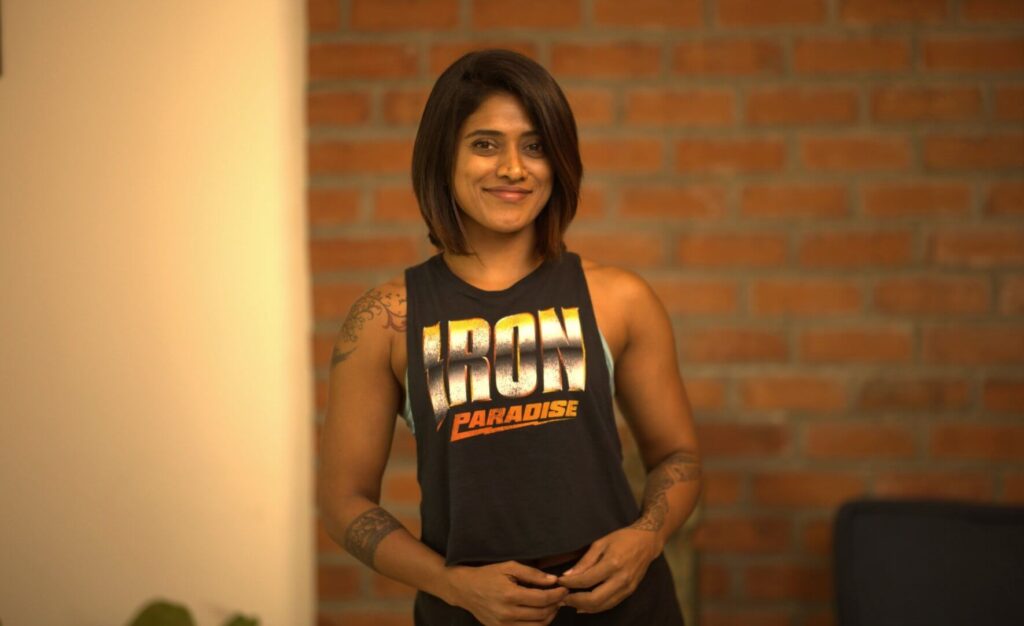Swetha works as a fitness coach with a background as a healthcare professional. She previously worked as a vascular radiologist in Bengaluru. In 2016, she started to coach people for their exercise regimes and found immense satisfaction in enhancing people’s lives through her passion. She realised it was a place she felt more suited to, as well as a stage that creates awareness about preventive healthcare.

Highlights
- A plant-based diet has helped me regulate my blood sugar and has brought down inflammation,
- I just turned 37 and I’ve never been fitter in my life. I lift heavier, I run faster and longer. I’m very curious to see how far I can go. I can’t wait to compete again,
- I think snacking is overrated. People just put on weight in the name of snacking because snacks become their mini-meals.
Swetha Devaraj – Animal Flow Workout & Plant-based Diets Expert
Swetha has always been a sporty person, who played pro tennis in India and college-level tennis at Alcorn State University in America. She then proceeded to cement herself as a runner, winning several marathons as well as obstacle races.
Swetha came to Animal Flow serendipitously. Following an ankle injury in 2018, she found that it offered both physical and mental benefits.
Ultrahuman got talking with Swetha about the role of diet in her fitness journey, and her take on Animal Flow as a training method.
Swetha, you’re a plant-based athlete. What made you want to switch to such a diet choice?
I follow a plant-based diet most of the time. There are times that I will indulge, maybe have some dairy over a weekend. But when I switched, I completely switched over to everything plant-based.
There was simply no dairy and no meat because of two reasons.
One is that I was borderline insulin resistant or prediabetic. This had taken place without my knowledge. Although, I know why, as my body was burning through everything I ate.
If you stop training or as you age, and don’t alter your nutrition to match your new lifestyle or reduced needs, your body will store fats. Muscle too is then built on top of this. When I was in that state, I wasn’t feeling good. I was bloated and had brain fog and fatigue even though I was active.
When I was working as a vascular radiologist, I got my bloodwork done, and found out about borderline pre-diabetes. There wasn’t great disposal of calories, and a lot of spikes were taking place.
Meat was a probable cause, and blood sugar regulation and inflammation could be related to it. These could be products of my lifestyle. Coupled with this, documentaries about vegetarianism, the planet, and animal agriculture left an impact on me. So, for health and planetary reasons, I decided to be completely plant-based.
I’m now strictly plant-based at home, although I do indulge in occasional dairy when I am being social or when my mother makes something. I no longer care for eggs or meat. Initially, I felt great from this change. There was weight loss and a lot of energy, that’s called the surge.
The plant-based diet has helped with my blood sugar regulation and brought down inflammation.
How did this choice shape your athletic journey?
I just turned 37 and I’ve never been fitter in my life. I lift heavier, I run faster and longer. I think it has everything to do with the way I eat. Inflammation plays a huge part. And a lot of meat, refined oils, and sugar cause inflammation in our bodies. Reducing all these things has helped me be a better athlete today. I’m just very curious to see how far I can go. I can’t wait to compete again.
What would you recommend to athletes who are looking to switch to a plant-based diet?
Definitely, ease into it. And don’t go Cold Turkey like me. It may initially feel great for the first year. But after that, it takes a toll.
So I’d say keep that journey going for about two years. Eat meat twice a week or dairy, and then slowly cut it down. It takes a year to completely adhere to it.
Make sure your meals are balanced because when you eat meat, you don’t see anything else – you only focus on meat and some carbs like chapati or rice.
It’s hard to meet your protein requirements if you’re a vegetarian. So I need a lot of vegetables that are actually rich in protein alone. Like today, for example, I ate multigrain chapatis, green gram curry with okra and cabbage. And then there was quinoa and brown rice. I emphasise meal prep because it is tedious to cook so much every day. Include three different types of veggies, carbs and grains like quinoa, amaranth and millets in your diet.
I’m a huge fan of intermittent fasting. I vary my fast every week but as a woman, I need to make sure I don’t go beyond 14 hours in the week because it can mess up your hormones. So my dinner usually ends by 5. 36 pm. I rise with the sun, I end my day with the sun. I’m a huge believer in the circadian rhythm.
Also, having six meals a day and having three rounds of snacks is a fad. You’re just constantly spiking your glucose levels. I think snacking is overrated. People just put on weight in the name of snacking because snacks become their mini-meals.

As you’re a qualified instructor, tell us about what drew you to animal flow training?
So Animal Flow is a ground-based bodyweight movement training done on all fours. It was inspired by break dance, parkour, and circus acts like hand balancing.
There are regressions to every progression, so even if you’ve never worked out in your life you can do it. You’ll find a lot of anatomical science explained along with each move we teach in the workshop. It’s very different from yoga or capoeira.
The ground has a proprioceptive (stimuli that are created and perceived within an organism, connected with the movement and position of the body) environment that feeds the sensory receptors in our hands and feet with input.
As we come into contact with the ground’s rich environment, there is communication in the form of motor and sensory responses from the ground through our feet and into our nervous system.
Today, people are overstimulated. I’ve seen so many of my clients at the gym so disconnected from their own bodies. And when you tell them to move one object from one place to another, they do it mindlessly. The minute I put a client on the ground, they have to think because they are not used to this. They try to connect with themselves. With Animal Flow, you gain more awareness from the positions of your limbs.
Crawling for instance is an important part of the human developmental process. As the baby crawls and connects with the ground, there’s also communication between the left and right hemispheres of the brain.
I come from a strength and conditioning background. With Animal Flow training, my mobility and flexibility got better. And now I’ve come a long way.
Anyone can try animal flow. It can be very dynamic, nice and relaxing. It enhances stability for flexible people like yoga instructors. It also enhances flexibility and mobility in people who train for strength, such as bodybuilders.
Animal Flow is a way of becoming a better mover and a better person who is well connected within oneself. Whatever you want Animal Flow to be, it can be.
Conclusion
The breadth of Swetha’s experiences as an athlete and healthcare professional are fascinating. That she has played pro tennis and competes regularly on the marathon circuit and worked as a vascular radiologist give her practical experience and academic knowledge, both of which complement each other in her lifestyle. Her plant-based diet helped her reduce inflammation and brought energy to her life. Her serendipitous discovery of Animal Flow and its mental and physical benefits inspired her to get certified and train more people in the form. In both examples, Swetha has found her way out of challenging situations through making personalised nutrition and lifestyle choices.
Disclaimer: The contents of this article are for general information and educational purposes only. It neither provides any medical advice nor intends to substitute professional medical opinion on the treatment, diagnosis, prevention or alleviation of any disease, disorder or disability. Always consult with your doctor or qualified healthcare professional about your health condition and/or concerns and before undertaking a new health care regimen including making any dietary or lifestyle changes.









